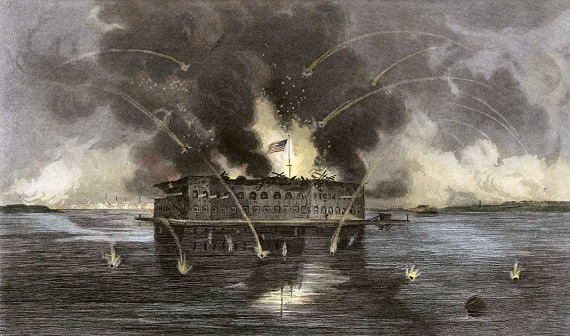George Orwell, in his dystopian novel 1984, wrote that “Ignorance is strength.” Big Brother thrives on it – whether in a totalitarian regime or in a pure democracy. In his government schools it would be easy and politically profitable for Big Brother to teach ignorance with flash cards. Take for example the “Civil War,” one of the defining events of American History:
Card #1: The War was fought over slavery.
Card #2: Lincoln freed the slaves.
Card #3: End of Story – Any Questions?
Well, yes. Wars are not fought over other peoples’ labor systems. They are fought over the control of energy resources. May we bring up the flash cards for Algebraic Equations and apply them to a comparison between England’s War to Prevent Colonial Independence in 1776 and the United States’ War to Prevent Confederate States’ Independence in 1861? Please pay attention as we develop these cards, which will be based upon an understanding of Mercantilism as an economic system for the control of energy resources.
A Mercantile system is an economic system comprised of an industrial, shipping and financial center, or “Core,” that directs the operation of the system, and an outlying agricultural “Periphery” which provides the Core with primary products for manufacturing and markets for its finished products. This system may be expressed algebraically as:
M = C + P
where M represents the mercantile system itself, and C and P represents the Core and Periphery respectively, the two major components that comprise the system.
With the coming of the Industrial Revolution, Mercantilism (M) replaced Feudalism in Europe as the primary economic system for controlling energy resources, classic examples being the Core European Powers (C) and their Peripheral “New World” colonies (P).
While a mercantile system may originate with mutual benefit to both of its parts, the system eventually develops a trade imbalance which is favorable to the Core at the expense of the Periphery. This is illustrated by the Argentine Economist Raul Prebisch’s Dependency Theory. Prebisch argues that the concentration of exports in primary commodities (raw materials) from the Periphery has a structural tendency to deteriorate the terms of trade, because the price of primary commodities exported from the Periphery rises more slowly than the cost of manufactured commodities imported from the Core. Thus the wealth of the Periphery gravitates towards the Core as profits, creating the trade imbalance against the Periphery. The Core – which then controls the system – dictates economic policy and exploits the Periphery as its economic “colony.” (Harry E. Vanden and Gary Prevost, The Politics of Latin America: The Power Game, Oxford: Oxford UP, 2002, pgs. 153-4, 156-60.)
That is what happened in the British mercantile system in 1776, driving the thirteen colonies to secede from the Empire, and driving Britain to wage a war against them to prevent it. After the war, New England – and eventually the industrializing Northeast as a whole, with its growing sectional majorities and its tendency to centralize the powers of the Federal Government into its own hands – developed the same mercantile relationship towards her sister agricultural States in the South that England had previously enjoyed with her colonies (Thomas Prentiss Kettell. Southern Wealth and Northern Profits [New York: 1860, p. 19]). In both cases the balance of trade became exploitative against the Periphery. In both cases it drove the Periphery to secession from the Core-controlled economic system. In both cases it drove the Core to launch a war of conquest against the Periphery in an attempt to drive it back under the Core’s control. These wars may each be expressed by the Algebraic Equation
C – P = W
where
C (the Core) – P (the secession of the Periphery) = W (War).
Applied specifically, we have
C (England) – P (The Thirteen American Colonies) = W (The War of 1776)
and
C (The United States) – P (The Confederate States) = W (The War of 1861).
So, what about slavery and emancipation? Steam power was replacing muscle power as the prime mover of civilization, and slavery (an obsolete and inefficient labor system) was ending it all over the world through natural economic dictates without the necessity of war. But in both of the cases we are discussing, the Periphery (the Thirteen Colonies in 1776 [see the 1790 US Census returns, Kettell p.120] and the Southern States in 1861) employed slave labor (S). In both cases, (Lord Dunmore in 1775 and Abraham Lincoln in 1863), the Core issued a limited emancipation proclamation (E) as a War Measure directed solely and specifically against the Periphery with whom they were at war. Factor these into each equation as a mathematical constant and we have:
C(E) – P(S) = W (1776), and C(E) – P(S) = W (1861)
If the factors on the left of each equation are the same, then those on the right are the same. Factor out C(E) – P(S) as a constant in both equations and we have:
W (1776) = W (1861)
Like George III, Lincoln waged a war of conquest, not of liberation. With the South’s “Cotton Kingdom” out of the North’s “Mercantile Kingdom,” the economic fortunes of the North would have collapsed, so Lincoln (a la George III) launched his war of invasion, conquest, and coerced political allegiance against the Southern States to drive them back into the Union and under the North’s control. The Confederacy was the American Empire’s first conquest, and slavery and emancipation were merely the moral covers for Yankee imperialism.
Today, if that Truth were to become known, the political fortunes of Big Brother (based upon the power of ignorance dispensed by Marxist demagogues who dupe the credulous for their votes and their riots) would collapse. No wonder he and his “useful idiots” and “rent-a-thugs” rage, and demand the removal of all Confederate monuments, for these monuments say to them as the Prophet Nathan said to King David (II Samuel 12:7) “Thou art the man”!







